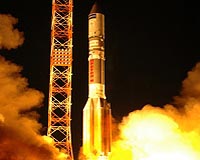 |
Paris, France (ESA) Jul 02, 2009 The Ariane 5's 31st consecutive mission success was another record-setting flight for this workhorse Arianespace launcher - lofting the world's largest commercial satellite, TerreStar-1, from the Spaceport in French Guiana. Lifting off from the ELA-3 launch zone on a rare afternoon departure, the Ariane 5 deployed TerreStar-1 into geostationary transfer orbit 26 minutes later. With a launch mass of nearly 6,910 kg., TerreStar-1 was carried as a solo payload on the heavy-lift Ariane 5 ECA mission, which followed Arianespace's most recent flight by less than two months. "This 31st consecutive success for Ariane 5 - which is our third launch in 2009 - perfectly illustrates that high performance and reliability can go hand in hand," said Arianespace Chairman and CEO Jean-Yves Le Gall. "Ariane 5 also has demonstrated its real capability to perform a complete range of missions - from launches of the heaviest commercial satellites to the most complex scientific spacecraft." Le Gall thanked TerreStar-1's operator - U.S.-based TerreStar Networks - for its confidence, noting this is the 29th new satellite company to have relied on Arianespace for the launch of an initial spacecraft. TerreStar-1 will be located at an orbital position of 111 deg. West, offering new-generation mobile communications services across the United States and Canada. It was produced at Space Systems/Loral's Palo Alto, California facility, and was the 34th spacecraft built by this U.S. satellite manufacturer to be launched by Arianespace. Operating in the 2-GHz spectrum with an 18-meter deployable reflector and powerful S-band feed array, TerreStar-1 will be able to manage some 500 spot beams. It is designed to supply secure communications services to governments in emergency situations, as well as to rural communities. The satellite also will provide voice, data and video transmission services to businesses via dual satellite/ground terminals approximately the size of a typical smart phone. In post-launch comments from the Spaceport's control center, TerreStar Networks President Jeffrey Epstein showed the type of handheld device that will function with the company's communications network and the TerreStar-1 satellite. He also expressed the excitement of experiencing the Ariane 5's launch first-hand. "We are deeply appreciative of Arianespace's efforts," Epstein said. "What we just witnessed is the culmination of millions of hours of advanced technology in satellite deployment here, and it's truly remarkable to watch."
An on-target flight, and a new Ariane 5 mission in August - Perigee: 249.9 km. For a target of 249.7 km. - Apogee: 35,941 km. For a target of 35,928 km. - Inclination: 6.01 degrees for a target of 6.00 At the completion of the mission, Arianespace's Le Gall announced that Ariane 5's next launch is set for mid-August, carrying a dual-satellite payload for two Asia-Pacific customers: JCSAT-12 for Japan's SKY Perfect JSAT Corp.; and Australia's Optus D3. Le Gall said Arianespace remains on track to perform seven Ariane 5 flights during 2009. The Ariane 5 ECA for its upcoming mid-August mission has completed the initial build-up in the Spaceport's Launcher Integration Building. This vehicle will now be readied for transfer to the Final Assembly Building - which opened up yesterday morning after the Ariane 5 with TerreStar-1 moved out to the launch zone. Arianespace's ability to prepare two Ariane 5s in parallel at the Spaceport is a key to its flexibility and reactivity - which is further enhanced by the heavy-lift workhorse's ability to orbit two primary satellite payloads on a single flight. The three Ariane 5 missions performed so far in 2009 have lofted a total of seven spacecraft with a combined payload mass of nearly 19,600 kg. Arianespace's first flight of the year was on February 12, orbiting the HOT BIRDT 10 and NSS-9 commercial telecommunications satellites, along with two Spirale auxiliary passengers for the French defense procurement agency. This was followed by the May 14 launch of Europe's Herschel and Planck deep space telescopes, which were placed on Earth escape trajectories for their 1. 5 million km. Voyages to the second Lagrange point (L2). Share This Article With Planet Earth
Related Links Arianespace Launch Pad at Space-Travel.com
 ILS Proton Launches SIRIUS FM-5 Satellite
ILS Proton Launches SIRIUS FM-5 SatelliteBaikonur, Kazakhstan (SPX) Jul 02, 2009 ILS International Launch Services (ILS) successfully carried the SIRIUS FM-5 satellite into orbit on an ILS Proton. This was the third commercial mission of the year for ILS and the fifth successful Proton launch of 2009. ILS has launched the entire SIRIUS three-satellite constellation beginning with the first launch in 2000. The ILS Proton Breeze M launched from Pad 39 at the cosmodrome ... read more |
|
| The content herein, unless otherwise known to be public domain, are Copyright 1995-2009 - SpaceDaily. AFP and UPI Wire Stories are copyright Agence France-Presse and United Press International. ESA Portal Reports are copyright European Space Agency. All NASA sourced material is public domain. Additional copyrights may apply in whole or part to other bona fide parties. Advertising does not imply endorsement,agreement or approval of any opinions, statements or information provided by SpaceDaily on any Web page published or hosted by SpaceDaily. Privacy Statement |